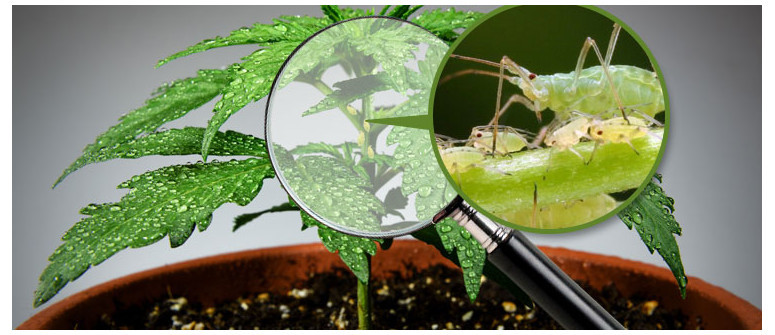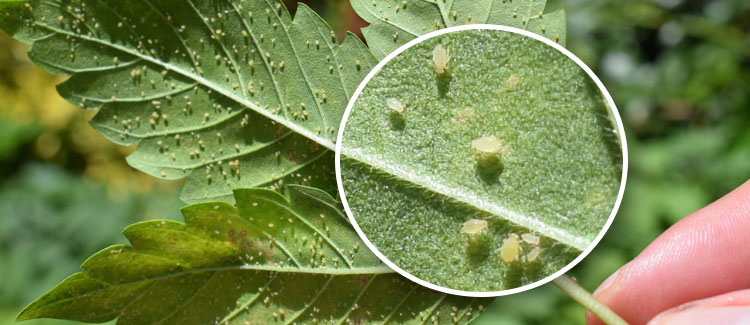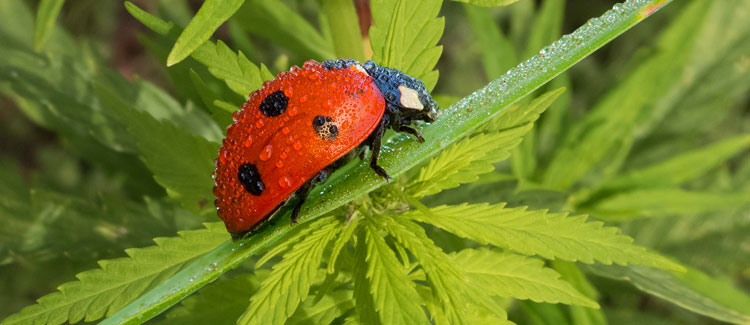Aphids and marijuana plants: how to prevent, identify and treat

Aphids pose a triple threat to cannabis growers. Not only do they damage and destroy leaves by sucking the sap out of them, but they can also harbor diseases and bring other unwanted pests to your growing area as a means of protection for themselves.
Aphids pose a triple threat to cannabis growers. Not only do they damage and destroy leaves by sucking the sap out of them, but they can also harbor diseases and bring other unwanted pests to your growing area as a means of protection for themselves.
APHIDS POSE A TRIPLE THREAT
What exactly is an aphid? Belonging to the insect group, Hemiptera, aphids are parasites that grow to roughly the size of a pinhead or 1-3mm. They are easy to spot with the naked eye and can appear in a variety of colors; however, most aphids are black, brown or green. Usually the difference depends on their foodsource.
Being graced with wings when needed, they can easily spread from plant to plant, although they typically congregate in colonies on the underside of leaves and remain there until the plant has no further benefit for them. They will destroy a plant entirely before moving on and repeating the process.
A unique characteristic of aphids is the secretion of a sugary substance referred to as “honeydew.” This sticky material is used to attract ants and in some cases bees. Aphids develop a symbiotic relationship with either insect and use them as protection against predators like ladybugs or wasps. There are known situations where ants bring aphids to a specific place in order to be able to later harvest their precious "honey dew"
The final blow to cannabis growers is aphids are also carriers of infectious diseases, and through the process of sucking the sap out of your cannabis leaves, they can pass that infection on.
SPOTTING AN APHIDS INFESTATION

Aphids pose a dangerous threat to cannabis plants, especially for those you opt to grow in tents or greenhouses. The warmer temperatures make these areas a haven for female aphids to reproduce. The issue is further worsened by the fact that their breeding cycle is relatively short, meaning in optimal conditions they can multiply at an alarming rate.
Spotting them is simple, they tend to congregate on the underside of leaves and around fresh stems. They are one of the few pests that plague cannabis that also attack the stem. The honeydew substance we referenced earlier also provides a telltale sign. Not only does honeydew attract additional pests, it encourages sooty mold to grow. Look out for black spots appearing on the top side of leaves.
The presence of their insect bodyguards is also a sign of aphid infestation. Although it is unlikely you will notice a build up of ants before you see aphids, their existence is still a telling indicator.
PREVENTATIVE MEASURES
Whether it is aphids or any other type of insect infestation, there are always two golden rules for dealing with them. Firstly, a clean, well maintained growing environment is the best defense against pests. This means removing any weeds, cleaning tools and refreshing substrate between cultivations. Secondly, rapid response to any pest threat will ensure the damage is mitigated. After spotting an infestation, immediate action is the best remedy, don't wait!
Regular observation is the first preventative measure you can take. Reviewing your plants on a weekly basis will make spotting aphids significantly easier. Be wary of warm, dry temperatures at the beginning of spring or using excess fertilizer. They can all encourage aphids to appear.
It is also worth noting that aphid eggs will lay dormant during winter and colder temperatures. This attribute enforces the need to refresh your entire growing area between harvesting to ensure there are not aphids laying in wait.
ADD NATURAL PREDATORS TO REMOVE APHIDS

If you want to use mother nature to your advantage, aphids have a large number of natural predators. Ladybugs are highly effective at dealing with an aphid infestation, so too are parasitic wasps and lace wigs. Releasing these predators when you notice the first stages of an aphid problem should result in the outbreak being dealt with naturally. If, however, you can't get hold of bulk amounts of bugs, or the infestation has gone unnoticed then organic pesticides are the next step.
HOMEMADE APHID SPRAY
Neem oil and insecticidal soap are both excellent options for dealing with aphids. They shouldn’t impact your buds as long as you avoid spraying them directly onto developing flowers. Available from garden centers, it is not difficult to acquire them; however, should you want a homemade remedy to aphids, the following spray is easy to create.
Using tomato leaves, finely chop enough to fill two cups. Combine with two cups of tap water in a jug large enough to hold both and leave to sit overnight.
Strain the liquid, removing the leaves and dilute with a further two cups of tap water. The finalized mixture can be added to a spray bottle and used to tackle aphids.
Focus the spray on the areas they like to collect, including stems. Be sure to avoid flowers, as you don't want your end product to have your spray on it. Some sprays may burn the young flowers, this is why it is important to cover only the leaf surface, although as thoroughly as possible.
.jpg)
.jpg)

.jpg)
